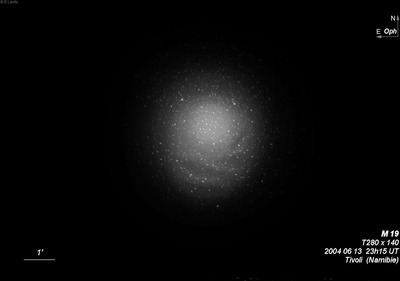
Charles Messier discovered M19 = NGC 6273 = h1975 = h3663 on 5 June 1764 and reported a "Nebula without stars, on the parallel of Antares between Scorpius and the right foot of Ophiuchus: this nebula is round; one can see it very well with an ordinary telescope of 3.5-foot focal length."
William Herschel first resolved the cluster using his 6-inch (10-foot focal length) on 28 May 1783, before his sweeps began. "I can count 5 or 6; & all the rest of the light appears mottled like other nebulas when not sufficiently magnified and illuminated to shew the stars." John Herschel, observing from Slough on 16 Apr 1828, recorded "a fine globular cluster, stars vS, 12...18m, with one = 10m, and one 10-11m; nearly R; vgpmbM, but does not come up to a blaze. Insulated; 3' diam. It forms a link between I. 70 [NGC 5634] and M10 or M12."
200/250mm - 8" (7/17/82): lively, two or three very faint stars are resolved at the north edge.
300/350mm - 13.1" (7/27/84): bright, elongated N-S, very mottled, brighter core. The outer edges barely resolves into one or two dozen stars at 220x.
13.1" (7/17/82): a number of faint stars just resolve at 280x, particularly around the south edge.
400/500mm - 17.5" (6/3/00): bright, moderately large globular, unusual appearance with an extended halo ~6'x4.5' (elongated N-S) and a bright 3.5' core. The cluster breaks up into several dozen stars at 220x and at 500x at least 50 stars are resolved over the entire face of the globular. There are a couple of strings of stars on the SE side of the halo with a dark lane between the strings. The brightest star (foreground?) is on the northeast side.
Notes by Steve Gottlieb